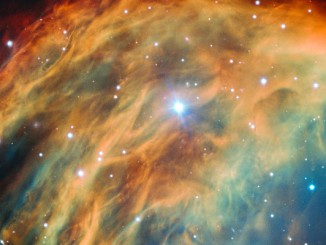
Discovered by William Herschel in 1785, NGC 246 is a large planetary nebula in a star-poor area of Cetus. It must have been quite challenging for him to find as he often used high powers and small fields when searching for nebulae. The central star, at 200,000 degrees Celsius, is one of the hottest known and is also one of the few such stars with obvious variability, as well as being a wide binary. More technically it is a PG1159 white dwarf which is likely to be the remnant of a Wolf Rayet-type central star.
The nebula itself shows obvious signs of interaction with the interstellar medium as the eastern limb is much brighter than the western limb. The star and the nebula appear to be moving in that direction as well. The complex structure within the limb of the nebula and the odd structure within the nebula is thought to be the result of shock waves as the stellar wind interacts with existing material. It is this detail that has given rise to its name as the Skull Nebula. The nebula is estimated to be about 1,600 light years away and at that distance it would have a diameter of 2.5 light years. Note, however, that the distances to most planetary nebulae are very poorly known.
Visually NGC 246 is a challenge, especially from mid northern latitudes where it never rises very high out of the murk. The listed magnitude of NGC 246 is around +8 but it is much harder to see than that might suggest because of its size, meaning its surface brightness is low. As such, when trying to observe it, wait until it is near the meridian when it is at its highest. The use of an O III or UHC nebular filter will also help and may even be a requirement. Although it has been reported as visible with telescopes as small as 100mm from high, dry locations it will probably require at least a 200mm from the UK. NGC 246 is much bigger (over twice the size) than M57 so you will need a low/medium power eyepiece to find it.
I find that its visibility varies; on nights of good transparency it is not that hard to find but on other nights it is difficult or impossible to see. The central star is surprisingly bright at eleventh magnitude and should be visible even if the nebula is not. There are several other stars close to the nebula.



